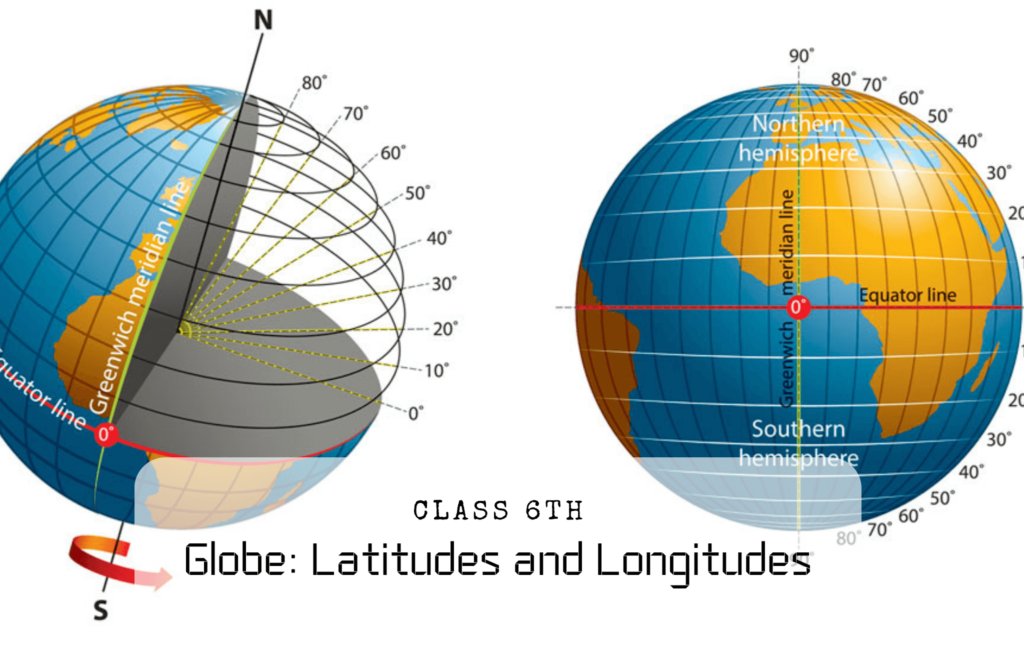
NCERT Solutions for Class 6 Geography Chapter 2 Globe: Latitudes and Longitudes

Chapter 2, Globe: Latitudes and Longitudes, covers a wide range of topics such as latitudes, longitudes, prime meridian, time, equator, etc. With the help of the globe, you can see the entire Earth at a glance. It shows you different countries, continents and oceans, along with their latitudes and longitudes. Latitudes and longitudes are measured in degrees and minutes.
NCERT Solutions for Class 6 Geography Chapter 2 Globe: Latitudes and Longitudes
1. Answer the following questions briefly.
(a) What is the true shape of the Earth?
(b) What is a globe?
(c) What is the latitudinal value of the Tropic of Cancer?
(d) What are the three heat zones of the Earth?
(e) What are the parallels of latitude and meridians of longitude?
(f) Why does the torrid zone receive the maximum amount of heat?
(g) Why is it 5.30 p.m. in India and 12.00 noon in London?
NCERT SOLUTIONS FOR CLASS 6 GEOGRAPHY CHAPTER 1 THE EARTH IN THE SOLAR SYSTEM UPDATED
Answer 1.
(a) The Earth is not a perfect sphere. It is slightly flattened at the North and the South Poles and bulges in the middle.
(b) A globe is a miniature form of the Earth.
(c) The latitudinal value of the Tropic of Cancer is 23½° N.
(d) The three heat zones of the Earth are as follows:
- Torrid Zone
- Temperate Zone
- Frigid Zone
(e) All parallel circles from the equator up to the poles are called parallels of latitudes. The lines of reference running from the North Pole to the South Pole are called meridians of longitude.
(f) The torrid zone receives the maximum amount of heat because it is present between the Tropic of Cancer and the Tropic of Capricorn. The sun is exactly over the head once a year on all the latitudes between these two tropics.
(g) India is located east of Greenwich at 82°30’E. It is 5 hours and 30 minutes ahead of GMT. So, it will be 5:30 p.m. in India, when it is 12:00 noon in London.
NCERT Solutions for Class 6 Geography Chapter 2 Globe: Latitudes and Longitudes
2. Tick the correct answers.
(a) The value of the prime meridian is
(i) 90° (ii) 0° (iii) 60°
(b) The frigid zone lies near
(i) The Poles (ii) the Equator (iii) the Tropic of Cancer
(c) The total number of longitudes are
(i) 360 (ii) 180 (iii) 90
(d) The Antarctic Circle is located in
(i) the Northern Hemisphere
(ii) the Southern Hemisphere
(iii) the Eastern Hemisphere
(e) Grid is a network of
(i) parallels of latitudes and meridians of longitude
(ii) the Tropic of Cancer and the Tropic of Capricorn
(iii) the North Pole and the South Pole
Answer 2.
- (ii) 0°
- (i) the Poles
- (i) 360
- (ii) the Southern Hemisphere
- (i) parallels of latitudes and meridians of longitude
3. Fill in the blanks.
(a) The Tropic of Capricorn is located at _________________.
(b) The Standard Meridian of India is ____________________.
(c) The 0° Meridian is also known as ____________________.
(d) The distance between the longitudes decreases towards___________.
(e) The Arctic Circle is located in the ____________ Hemisphere.
“SPARK OF CHANGE: HOW ELECTRIC VEHICLES ARE SHAPING TOMORROW’S TRANSPORTATION”
Answer 3.
(a) The Tropic of Capricorn is located at 23½° S.
(b) The Standard Meridian of India is 82½° E Longitude.
(c) The 0° Meridian is also known as the Prime Meridian.
(d) The distance between the longitudes decreases towards the poles.
(e) The Arctic Circle is located in the Northern Hemisphere.
Tag:English, Social Science



